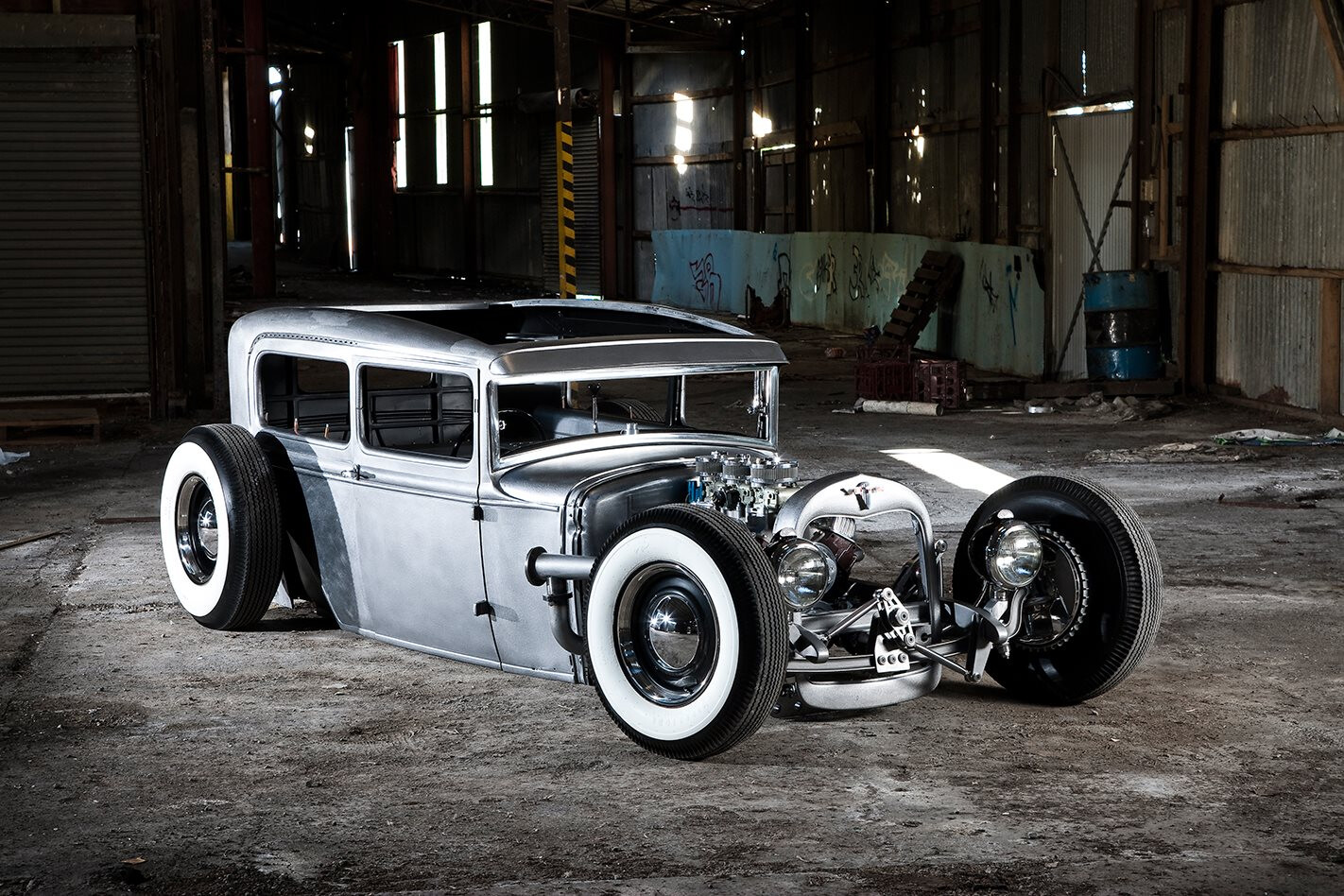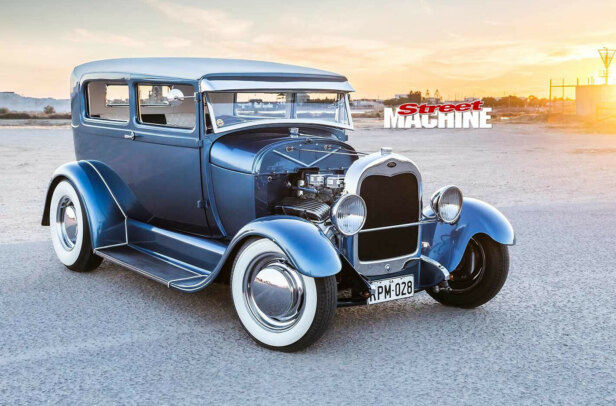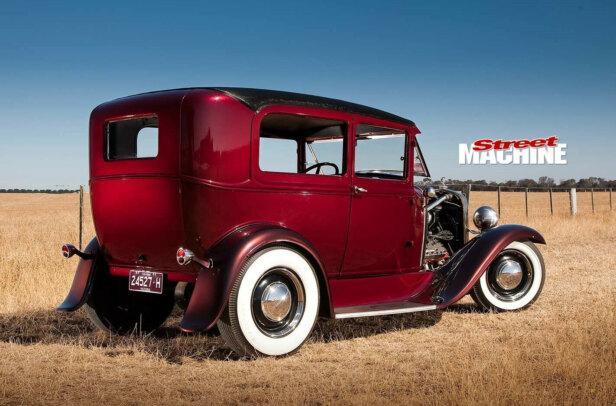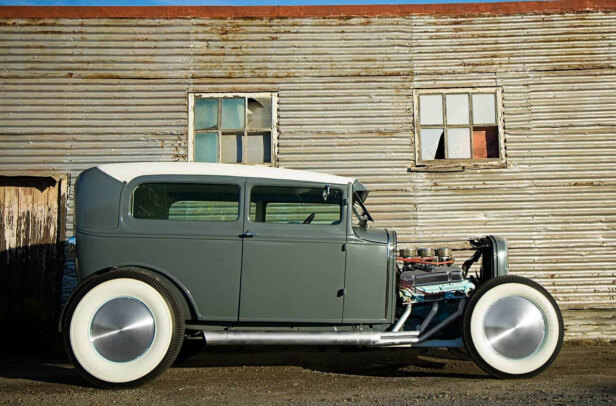GRAEME Brewer doesn’t mince words. He is a straight shooter in the classic sense of the term, especially when it comes to his ’31 Ford tudor.
That’s something of an accomplishment, because the real steel, traditionally styled Ford you’re checking out on these pages is not what he started building.
“The tudor started off as a 1928 Essex pick-up, but that was originally a sedan body and had been cut-down into a pick-up by a previous owner,” explains the 29-year-old. “It all came back to money as I wanted to build a Model A but couldn’t afford it. So I got the Essex project cheap off a mate. It was supposed be a rat I’d just throw together and drive it all rough, as I just wanted a hot rod on the road. But it just snowballed and I couldn’t just have it as a rat rod so I started building something schmick.”
Schmick is the understatement of the decade when it comes to Graeme’s creation. It is a super-slammed blend of traditional styling cues with modern suspension architecture and picture perfect metalwork. With the on-point welds and file-work it’s almost fabrication pornography.
It’s something Graeme prides himself on, being the owner and founder of Down Town Kustoms. Located in Taree on the North Coast of New South Wales, Graeme, his lead fabricator Damien Parker and fourth-year apprentice Jye Benning turn out killer rides that are built from scratch. But this hot rod is special, because it’s Graeme’s own project and one he’s dreamed of building since he was in shorts.
He bought the 1928 Essex chassis and cut-down body off a mate in Forster. It was rough as guts, but it was cheap, and this was an important factor as setting up and running a business full-time meant that any hot rod build had to be supremely budget-conscious.
To this end, Graeme figured he’d slap together a ratty jalopy and enjoy cruising around the North Coast, but then the familiar snowball started rolling.
“The body started pissing me off as someone else had chopped the sedan down into a pick-up. Working on the original body just wasn’t happening so I put it on the mezzanine and thought it’d be a good idea to build my own body from scratch. I built all the framing for that, which people might’ve seen photos of on the Internet.
“Because it’s my car I don’t have time to work on it much, so I’ve just got to try and get things done as quickly as possible. I ended up getting to the point where I was too busy on weekends to come in and hand-fabricate all the panels on it – it was too much of a job.”
Around the same time that Graeme was beginning to feel the frustration of having no free time to work the body, an original steel tudor body popped up on eBay. It was dry-as with no rust in it, good floor and came with a chassis. “The guy wanted 14K for it, but I got it for 10,” he says.
While the body was rot-free, it wasn’t without issues, having picked up plenty of dings and imperfections over the previous 83 years. The boys set about chopping the roof three inches and channelling the body, adding sheetmetal floors and a shaved firewall, removing the fuel tank and filler, and blending the sun-visor into the roof, which also copped all-new front tin. It was then file-finished for debut at the 2013 Motorex show.
From there, it was a matter of making Henry’s body fit the Essex chassis Graeme had already customised to sit flat on the floor thanks to airbag suspension.
“I made the body fit by cutting the rear of the chassis off and stretching it out, then making all-new rear suspension for it, while the cantilever front suspension is the same as what I had in the Essex,” he explains.
Cantilever suspension? Yep, automotive body building is only one of the tricks up the DTK boys’ sleeves; they’re also specialists in chassis and suspension fabrication, having cut their teeth on the mini truck scene.
Basically, the heavily notched Essex frame was set up by the boys to run a mix of traditional and new-age parts, including 1940 split wishbones and a four-inch drop-beam, with an IDITIT collapsible steering column. Graeme then fabricated from scratch the bell-crank cantilever suspension framework, with inboard Shockwave air struts to handle spring and damper duties, and his own custom-designed watts link for side-to-side movement.
The tudor can lay its sills on the ground, but still cruise at a comfortable height, bang corners with aplomb and stop on a 20c piece thanks to the So-Cal disc brakes up front. Yep, hiding behind the period-looking finned drums are Wilwood ventilated discs and two-piston calipers, though the 15×6.70 and 15×8.20 Firestone wide-whites will ultimately limit the rod’s handling prowess.
The rear-end suspension is more conventional. A scratch-built four-link hangs off a DTK designed and built rear chassis clip, and Slam Specialties airbags and KYB shocks work on the Ford nine-inch diff.
Graeme built the tudor as a driver, which called for dependability and reliability on the open road. To this end there’s a crate 350 Chev up front, dressed to impress with triple Barry Grant Six Shooter carburettor kit, custom DTK lakes-style headers and finned rocker covers. It is backed by a Turbo 350, Lokar shifter and custom tailshaft.
Inside is still considered a work-in-progress, but the 1940 Ford tiller and Classic Instruments are joined by eBay find seats. It’s almost going to be a shame if Graeme decides to hide the custom metalwork under luxurious carpet!
“I love things that are low, and at the start it was just meant to be a hot rod on bags that’d lay flat on the ground,” says Graeme. “Now, it is a good promotional tool for the shop as it showcases everything we can do here – chassis fabrication, suspension engineering and fabrication, sheetmetal work, bodywork and more.
“I’d love to leave it bare metal as it’s so straight, but I want to paint it just to show we can take a car from start to finish with all of the processes in between done in-house. I want to take it to the next level and make it a show car; it’s already all good, it just needs to be painted really well and maintain the quality.”
That is one step closer to reality now that DTK have added a full paint and panel section to their shop, including a top-shelf spray booth, though Graeme hasn’t decided on a colour for the tudor just yet. Whatever hue it’ll be painted, he’s already mentally committed himself to it not being perfect for long.
“It’ll be a full driver,” he says. “Once I’ve done the show circuit I’ll drive it and drag it along the road. Hell, if I move closer to work I’ll drive it to the shop each day, in summer.”




Comments